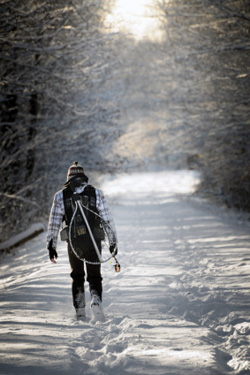Gear: Getting a Bang for Your Buck
Have a question you want answered? Email it to us at [email protected].
Question: I started fly fishing for trout last year and really want to get into it this coming season. However, I don’t have enough money to buy top-notch everything. What’s the best way to spend the money I do have to get the most bang for my buck and have adequate gear?
Jason T., Franconia, NH

Jeff Feverston photo
Answer: The good news is that there is a ton of excellent gear in the mid-to-low price range. Focus the lion’s share of your available funds on the essential pieces of equipment—rod, waders, and reel, in that order. Let’s assume that you have $600 to work with, but you can use these ratios based on any starting amount.
The largest portion, say 1/3, should go toward purchasing the rod. That means you’ve got $200 to spend. Ten years ago, there were hardly any good fly rods to be had at this price, but over the last decade the offshore rods have improved immensely. For most of the large manufacturers, this price will get you their low-end rod, but that doesn’t mean it’s crap. These companies are trying to develop brand loyalty, so they give you a good product at the low end in hopes that when you’re ready to trade up, you’ll buy one of their fancier models. Other manufacturers specialize in this price range. Take the time to work with your local fly shop to find a rod that fits your casting stroke, and this will help you learn the sport faster and easier.
Next come the waders and wading boots. You’re obviously not in the market for the $600 all-the-bells-and-whistles bombproof products. Instead, you’ll want to focus on waders made from technology that’s a few years older. As companies bring new products to market, they usually shift the older ones down the price ladder. So the $150 waders you can buy now were top-of-the-line five or six years ago. That means they’re still pretty good. You’ll end up sacrificing some durability, breathability, and a few pockets. And maybe a zipper. But if you tread carefully, they should last several seasons. You can find a comfortable pair of wading boots for around $100.
Based on where you live, I assume that you won’t generally be casting to really large fish, so you won’t need a reel that will stop a truck. High-tech disc drags using space-age polymers are neat, but most fly fishermen rarely get a trout on the reel in the first place. Don’t spend more than $100.
That leaves you $50 for a floating fly line and some tippet material. Add a pair of nail clippers, and you’re good to go.
The most important thing to remember is that no piece of fly-fishing gear is going to make you cast or fish better. Yes, good equipment makes the process easier or more comfortable, and there is definitely pleasure to be derived from a beautifully designed and built rod or reel. But never forget that, even if you had top-of-the line everything, Steve Rajeff could probably outcast and outfish you using a curtain rod and 100 feet of clothesline. No gear will substitute for skill.











